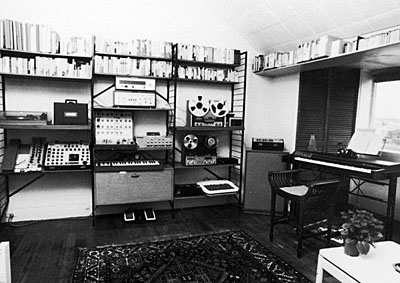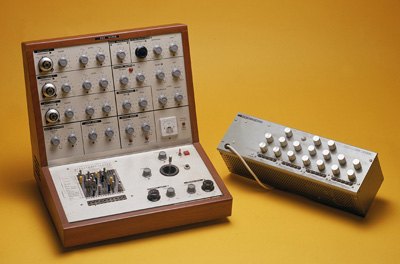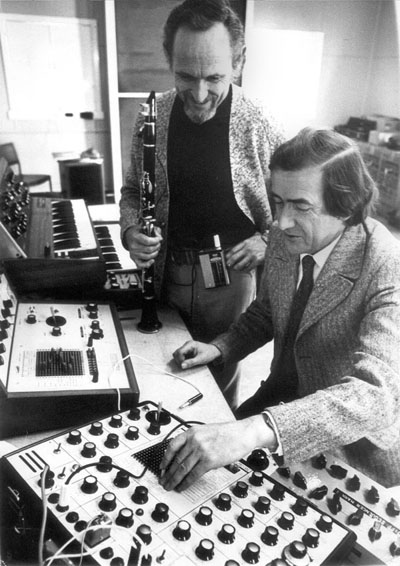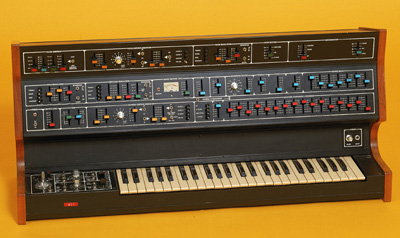Switched on
 ... a story of Australian innovation and a story of British innovation, from the collection of the Powerhouse Museum the EMS VCS 1 - prototype to the EMS VCS 3 In 1983 the Powerhouse museum purchased the music and recording instruments that comprised the Australian composer Don Banks' electronic music studio. The contents of this studio include the EMS VCS 1 (Electronic Music Studios Voltage Controlled Synthesiser attempt #1), a prototype for the VCS 3 - the first portable synthesiser.
In 1967 the Australian composer Don Banks was living and working in London. He approached three friends and colleagues who had been building their own electronic instruments, for advice on electronic music. Don was aware of modular systems such as the Moog and wished to begin experimenting with electronic music, but access to and affordability of these types of modular systems was prohibitive. Peter Zinovieff, David Cockerell, Tristram Cary and Don Banks continued this meeting at the pub where it was agreed they would build Banks a useful synthesiser for £50. The VCS 1 is the result of that venture into designing and building a useful and portable electronic music synthesiser.
By 1969, the design team of Zinovieff, Cockerell and Cary had developed a VCS2 (abortive and intermediate) followed by the VCS3, the first commercial product to come from EMS. This team comprised two electronic music practitioners and an engineer and this is reflected in the product they developed - the VCS3 is not a keyboard instrument nor was it designed with the traditional musician in mind. However its versatility and weirdness combined to attract a who's who of pop musicians including Brian Eno, Pink Floyd, Stereolab, Yes, Aphex Twin, Autechre, Meat Beat Manifesto, Jean-Michel Jarre, Astral Projection, Vince Clarke, Todd Rundgren, Recoil, Freddy Fresh and many more. The synthesiser was also adopted by just about every music laboratory and tech college as a valuable teaching tool for sound processing, acoustics and analogue audio synthesis. Along the way the VCS3 also picked up a healthy cult following and is still in use and production today. Thanks to Tristram Cary and David Cockerell for their invaluable advice. the Qasar II & M8 - towards the Fairlight CMI Around 1965, Tony Furse became interested in the digital synthesis of sound. His early experiments in this field were small flip-flop circuits. These experiments soon advanced and by the early 1970s Tony had completed a prototype digital/analog hybrid synthesiser - the Qasar. Unfortunately the completion of this prototype coincided with the release of the minimoog synthesiser, a cheaper analog synthesiser. Because the Qasar relied upon expensive microprocessor technology, any ideas for a production model of the Qasar were effectively squashed.
Undaunted, Tony Furse forged ahead with the Qasar II, a more ambitious duo phonic digital/analog hybrid synthesiser. The development of the Qasar II was supported by Federal government funding from the Australia Council. Tony also found great support from The Canberra School of Music and Don Banks in particular. Tony's research extended as far as reports of the system employed by the EMS electronic studio in London, frequent correspondence with Don Banks and exposure to other electronic instrument designers, users and manufacturers. From this wide body of knowledge Tony developed new ideas for what a computer music instrument could be capable of and these developments were incorporated into the design of the next prototype the Multimode 8, or the M8 for short.
The M8 was a very different machine to the Qasar series. It was conceived and built as a highly versatile discrete component system that would take full advantage of computing power. The M8 CPU was a dual parallel processor and 8 channel cards addressed a common memory. Many of the innovations that were to make the Fairlight CMI a great instrument have their genesis in the M8. Tony's designs incorporate hardware and software capable of interpolating harmonics for simple digital waveforms, sequencing software, visual display of waveform characteristics and notation and control of these with the light pen. Tony even envisaged a peripheral device that could read traditional notation and perform it.
|




